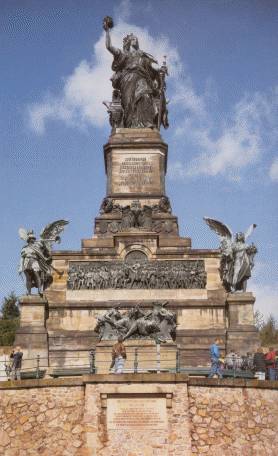Vita and Opus
|
1821 |
Since 1821 Johannes Schilling’s father Julius Schilling worked as a company officer, authorised to sign, for Gottlob and Traugott Dietze, Mittweida. Together with his wife Anna Schilling he lived in Rochlitzer St. 9. |
|
1828 |
On 23 June Johannes was born, the fifth and youngest child in the family. On 6 July he was christened by the deacon in the Lutheran church of Mittweida. He grew up with his sister Marie, three years his senior. |
|
1829 |
The family moved to Dresden, because Julius Schilling became a managing director in the Dresden Gasworks. |
|
1834-1842 |
He attended Böttcher’s Private School in Dresden. |
|
1842-1850 |
Student at the Royal Saxon Academy of Arts, Dresden. In 1845 he changed from the drawing class to the modelling class of Ernst Rietschel. |
|
1851-1852 |
Studies in the studios of F. Drake and C. D. Rauchs in Berlin. |
|
1851 |
Trip to Copenhagen: visit of the Thorvaldsen-Museum. |
|
1852 |
Return to Dresden. |
|
1853 |
Started to assist in the studio of E. J. Hähnel in Dresden. |
|
1854 |
After completing his studies in Hähnel’s and Reise’s studios, he went on a trip to Rome. In Munich he met F. Pecht and M. von Schwindt. |
|
1855 |
The Dresden Acadamy of Arts granted him a scholarship to study in Rome. In Rome friendship with A. Wittig and H. Wislicenus. |
|
1856 |
Opening of his studio in Dresden. |
|
1857 |
Marriage to his childhood friend Louise Isidora Arnold. |
|
1858 |
Birth of his eldest daughter, Katharina Susanna. |
|
1859 |
Birth of his eldest son, Georg Rudolf Schilling, later architect (Schilling-Museum) and government building officer in Dresden. |
|
1860 |
Schilling won the competition held for sculptures on the terrace in Dresden. In 1871 “The Four Times of Day” group was set up on Brühl’s Terrace. |
|
1862 |
Birth of his second daughter, Anna Sophie. |
|
1864 |
Birth of his third daughter, Clara Elisabeth, whose facial features he had in mind when he made “Germania”. King Johann of Saxony made Schilling an honorary member of the Royal Saxon Academy of Arts. |
|
1868 |
Winner of the competition held for a monument in memory of Emst Rietschel (inaugurated 1876). Appointment as Professor and director of sculpture at the Dresden Academy of Arts. |
|
1870 |
Winner of the competition held for the monument in memory of the Emperor Maximilian (inaugurated 1876) in Triest and the Schiller-Monument in Vienna (inaugurated 1875). |
|
1871 |
Commission for the Panther Quadriga on Semper’s second Court Theatre (inaugurated 1877). |
|
1872 |
Winner of the competition held for the monument in memory of the soldiers of Hamburg who were killed in the Franco-Prussian War of 1870/71 (inaugurated 1877). |
|
1872-1874 |
Participant in the competition held for the Niederwalddenkmal. Schilling’s third design was accepted. |
|
23.6.1877 |
He was awarded an honorary citizenship by the city of Mittweida. |
|
1879 |
By his offer to build the “Germania” figure ten metres in height without extra charge Schilling got in financial trouble. |
|
1880 |
Schilling’s wife Louise Isidora died. In deep mourning he made the bust of his wife. Schilling made portrait busts of his children. |
|
1881 |
Because of his financial problems he accepted a commission for fourteen statues of scholars in Strasbourg University (put in place in 1884). |
|
1882 |
The Emperor Wilhelm I visits Schillings’s studio in Dresden. |
|
3.9.1883 |
The German Emperor gave a present of 30,000 Mark. With this money they started to build the Schilling-Museum in Dresden. He was awarded an honorary citizenship by the City of Dresden. |
|
18.10.1883 |
A torchlight procession of the Dresden Arts Association, students and citizens of Dresden in honour of Schilling. Inauguration of the Monument to the memory of the Reformation in Leipzig. |
|
1888 |
Tomb monument in memory of Richard Hartmann in Chemnitz. Inauguration of the Schilling Museum in Dresden. Marriage to Minna Auguste Natalie Neubert. |
|
1889 |
The inauguration of the King Johann Monument on the theatre square in Dresden is the climax of the celebration of the 800th anniversary of the House of Wettin. |
|
1892 |
Inauguration of a monument in memory of Gottfried Semper in Dresden. |
|
1893 |
Erection of the tympanum above the entrance of the “Kunstausstellungsgebäude” (exhibition building) in Dresden. |
|
1894 |
Birth oh his second son, Heinrich. |
|
1895 |
The four statues, Research, Truth, Love and Justice in the Reichstag building in Berlin. |
|
1898 |
Three large female Art Nouveau statues were made. The Danaide is shown at the Great Exhibition in Berlin. - 23 June: His native town Mittweida sends congratulations on Schilling’s seventieth birthday. |
|
1899 |
Working in polychrome and polymorphous statue. |
|
1900-1901 |
He builds his own house in Dresden-Klotzsche. |
|
1903 |
Inauguration of the Wilhelm I Monument in Hamburg. |
|
1906 |
Publication of his book "Künstlerische Sehstudien", a critical summary of Schilling’s studies of the artist’s way of seeing, that had kept him busy over decades. Exploration of the limits and possibilities of photography. Retirement. |
|
23.3.1910 |
Johannes Schillings dies of a stroke in his house in Dresden-Klotzsche. Burial in Dresden, later the coffin was transferred to the Schilling family vault in Meissen-Zscheila. |
Taken from: Bärbel Stephan: Sächsische Bildhauerkunst. Johannes Schilling, 1828-1910. Berlin: Verlag für Bauwesen, 1996.
 Inauguration of the Niederwalddenkmal in
Rüdesheim am Rhein.
Inauguration of the Niederwalddenkmal in
Rüdesheim am Rhein.